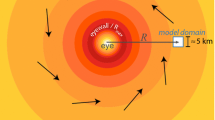Summary
A shallow water single level primitive equation model is ideally suited for studying the motion of a tropical cyclone. Three factors seem to be important in the initialization, i.e. the size, intensity and the initial speed and direction of motion of the storm. This study presents the results of sensitivity studies on the above parameters in the definition of a synthetic idealized vortex. The sensitivity studies include results of experimental forecasts for typhoons Betty of 1987 and Dan of 1989. The results of these studies show that the initial size, intensity and direction and speed of motion show considerable sensitivity to the predicted track. Finally a summary of the track forecast errors through 72 hours are presented for these storms.
Similar content being viewed by others
References
Andersson, E., Hollingsworth, A., 1988: A typhoon bogus observations in the ECMWF data assimilation system. Tech. Memo. No. 148, ECMWF, 25pp. Available from the European Center for Medium range weather forecast. Sheinfield Park, Berkshire, England.
Birchfield, G. E., 1960: Numerical prediction of hurricane movement with the use of fine grid.J. Meteor.,17, 405–414.
Chan, J. C. L., Gray, W. M., 1982: Tropical cyclone movement and surrounding flow relationships.Mon. Wea. Rev.,110, 1354–1374.
Demaria, M., Lawrence, M. B., Kroll, J. T., 1990: An error analysis of Atlantic tropical cyclone track guidance models.Weather and Forecasting.,5, 47–61.
Dong, K., Newmann, C. J., 1986: The relationship between tropical cyclone motion and environmental geostrophic flows.Mon. Wea. Rev.,114, 115–122.
Fiorino, M., Elsberry, R. L., 1989: Some aspects of vortex structure related to tropical cyclone motion.J. Atmos Sci.,46, 975–990.
Hitsuma, M., 1990: Current activities and future plan of the RSMC Tokyo-Typhoon Center. ESCAP/WMO Typhoon Committee 23 Session, Seoul, 1990.
Holland, G. J., 1983: Tropical cyclone motion: Environmental interaction plus a beta effect.J. Atmos. Sci.,40, 328–342.
Joint typhoon warning center, 1987: The 1987 annual tropical cyclone report.
Joint typhoon warning center, 1989: The 1989 annual tropical cyclone report.
Kasahara, A., 1957: The numerical prediction of hurricane movement with the barotropic model.J. Meteor.,16, 386–402.
Krishnamurti, T. N., Kumar, A., Xiang Li, 1987: Results of extensive integrations with simple NWP models over the tropics during FGGE.Tellus,39A, 152–160.
Krishnamurti, T. N., Oosterhof, D., 1989: Prediction of the life cycle of a supertyphoon with a high-resolution global model.Bull. Amer. Meteor. Soc.,70, 1218–1230.
Krishnamurti, T. N., Oosterhof, D., Dignon, N., 1989: Hurricane prediction with a high resolution global model.Mon. Wea. Rev.,117, 631–669.
Mathur, M. B., 1991: The NMC's Quasi-Lagrangian model for hurricane prediction.Mon. Wea. Rev.,119, 1419–1447.
Milne-Thomson, L. M., 1968: Theoretical hydrodynamics. London: Macmillan Press, 743 pp.
Neumann, C. J., Plissier, J. M., 1981: Models for the prediction of tropical cyclone motion over the North Atlantic: An operational evaluation.Mon. Wea. Rev.,109, 522–538.
Sanders, F., Pike, A. C., Gaertner, J. P., 1975: A barotrophic model for operational prediction of tracks of tropical storm.J. Appl. Meteor.,14, 265–280.
Trinh Van Thu, 1982: Use of the empirical orthogonal expansion coefficients in a statistic model for forecasting typhoon displacement. Extended abstracts of papers presented at the Regional Scientific Conference on Tropical Meteorology (Tsukuba, Japan, 18–22 Oct. 1982). WMO program on research in tropical meteorology, 227–228.
Yap, K. S., 1987: Documentation on two simple tropical models. WMO, Tropical Meteorology Program, Report No. 26., 116 pp.
Author information
Authors and Affiliations
Additional information
With 8 Figures
Rights and permissions
About this article
Cite this article
Thu, T.V., Krishnamurti, T.N. Vortex initialization for typhoon track prediction. Meteorl. Atmos. Phys. 47, 117–126 (1992). https://doi.org/10.1007/BF01025612
Received:
Revised:
Issue Date:
DOI: https://doi.org/10.1007/BF01025612




